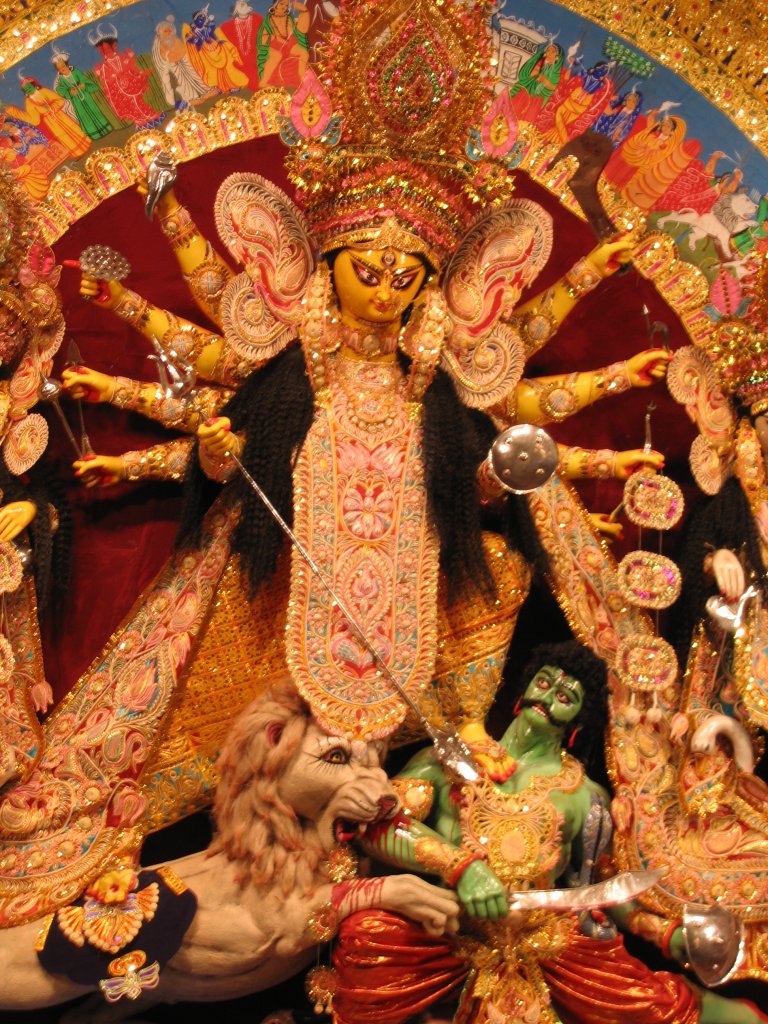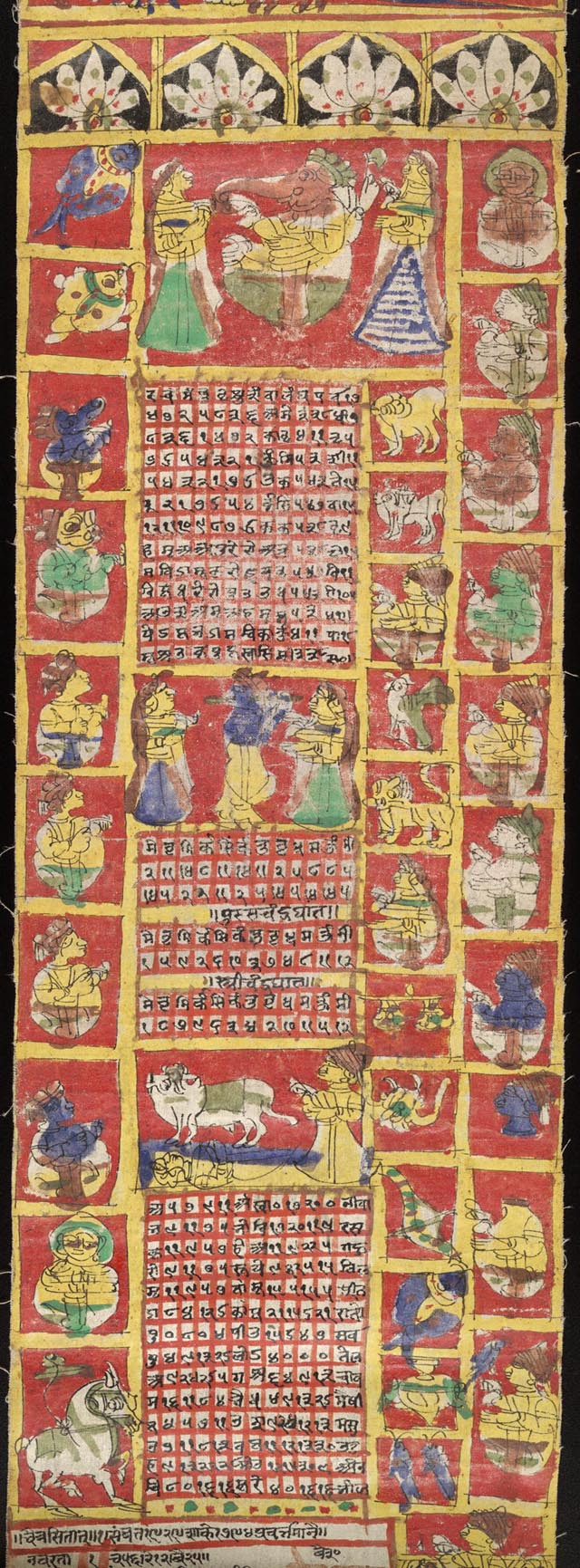|
Sharad (Indian Season)
Sharada or Śāradā is the autumn season in the Hindu calendar. It roughly corresponds to the months of Bhadrapada and Ashvina, or Ashvina and Kartika, and the western months of mid-September to mid-November. Sharada is preceded by Varsha and followed by Hemanta. Occasions Sharad Navaratri is marked on the first nine days of the season, regarded to be auspicious. Sharad Purnima is the full moon day in the month of Ashvina, which commemorates the performance of the rasalila dance by the deity Krishna Krishna (; Sanskrit language, Sanskrit: कृष्ण, ) is a major deity in Hinduism. He is worshipped as the eighth avatar of Vishnu and also as the Supreme God (Hinduism), Supreme God in his own right. He is the god of protection, c .... References Sources *Selby, Martha Ann (translator). ''The Circle of Six Seasons'', 2003, * Raghavan, V. ''Ṛtu in Sanskrit literature'', Shri Lal Bahadur Shastri from Nepal, 1972. Hindu calendar Autumn {{Hi ... [...More Info...] [...Related Items...] OR: [Wikipedia] [Google] [Baidu] |
Durga Puja Köln 2009 2
Durga (, ) is a major Hindu goddess, worshipped as a principal aspect of the mother goddess Mahadevi. She is associated with protection, strength, motherhood, destruction, and wars. Durga's legend centres around combating evils and demonic forces that threaten peace, prosperity, and dharma, representing the power of good over evil. Durga is believed to unleash her divine wrath against the wicked for the liberation of the oppressed, and entails destruction to empower creation. Durga is seen as a motherly figure and often depicted as a beautiful woman, riding a lion or tiger, with many arms each carrying a weapon and often defeating demons. She is widely worshipped by the followers of the goddess-centric sect, Shaktism, and has importance in other denominations like Shaivism and Vaishnavism. The most important texts of Shaktism, Devi Mahatmya and Devi Bhagavata Purana, revere Devi (the Goddess) as the primordial creator of the universe and the Brahman (ultimate truth and reali ... [...More Info...] [...Related Items...] OR: [Wikipedia] [Google] [Baidu] |
Hindu Calendar
The Hindu calendar, also called Panchangam, Panchanga (), is one of various lunisolar calendars that are traditionally used in the Indian subcontinent and Southeast Asia, with further regional variations for social and Hindu religious purposes. They adopt a similar underlying concept for timekeeping based on sidereal year for solar cycle, solar cycle and adjustment of lunar cycles in every three years, but differ in their relative emphasis to moon cycle or the sun cycle and the names of months and when they consider the New Year to start. Of the various regional calendars, the most studied and known Hindu calendars are the Shaka era, Shalivahana Shaka (Based on the Shalivahana, King Shalivahana, also the Indian national calendar) found in the Deccan Plateau, Deccan region of Southern India and the Vikram Samvat (Bikrami) found in Nepal and the North and Central regions of India – both of which emphasize the lunar cycle. Their new year starts in spring. In regions such as Tamil ... [...More Info...] [...Related Items...] OR: [Wikipedia] [Google] [Baidu] |
Bhadra (Hindu Calendar)
Bhadra or Bhadrapada or Bhādo or Bhadraba ( Bengali: ভাদ্র ''bhādro''; Hindi: भादों ''bhādo''; Sanskrit: भाद्रपद ''bhādrapada''; ''Bhādra''; ''Bhādravo''; ''Bhadraba''; ''Bhadô'') is the sixth month of the Hindu calendar, which falls in August and September of the Gregorian calendar.Henderson, Helene. (Ed.) (2005) ''Holidays, festivals, and celebrations of the world dictionary'' Third edition. Electronic edition. Detroit: Omnigraphics, p. xxix. In India's national civil calendar (Shaka calendar), Bhadra is the sixth month of the year, beginning on middle of August and ending on middle of September (date varies). In Hindu astrology, Bhadra begins with the Sun's entry into Leo and is the sixth month of the year. In lunar religious calendars, Bhadra begins on the new moon or full moon in August or September and is the sixth month of the year. The festival of Ganesha Chaturthi, which celebrates the birthday of Ganesha, is observed ... [...More Info...] [...Related Items...] OR: [Wikipedia] [Google] [Baidu] |
Ashvin (month)
Ashvin or Ashwin or Ashwan (; ; Malay/ Indonesian: ''Aswin''; Thai: ''Asawin''), also known as Aswayuja, is the seventh month of the lunisolar Hindu calendar, the solar Tamil calendar, where it is known as Aippasi, and the solar Indian national calendar. It is the sixth month of the solar Bengali calendar and the seventh of the lunar Indian calendar of the Deccan Plateau. It falls in the season of ''Sharada'', or autumn. In Hindu astrology, Ashvin begins with the Sun's enter into Virgo. It overlaps with September and October of the Gregorian calendar and is the month in which Diwali, the festival of lights, is celebrated according to the amanta tradition (Diwali falls in Kartika according to the purnimanta tradition). In lunar religious calendars, Ashvin begins on the new moon or the full moon around the time of the September equinox. Etymology Ashvini is the first star that appears in the evening sky. In Indian astrology, it is the head of Aries, or the first of the 2 ... [...More Info...] [...Related Items...] OR: [Wikipedia] [Google] [Baidu] |
Kārtika (month)
Kārtika (,) is the eighth month of the Hindu calendar, which falls in October and November of the Gregorian calendar. In India's national civil calendar. In most Hindu calendars, Kartika begins with the transit of the Sun into Libra, beginning on 18 October and lasting until 15 November. In the Nepali calendar, which is also the country's official calendar, Kartika is the seventh month of the year, similar to the Maithili and Bengali calendars. In Bengal, Kartika marks the start of the dry season ( ''Hemôntô''). In the solar Tamil calendar, ''Kārttikai'' (கார்த்திகை, ) is the seventh month, corresponding to November/December in the Gregorian calendar. It begins when the sun enters the sign of Scorpio. Many festivals, such as Karthikai Deepam, are celebrated in this month. Etymology The name of the month is derived from the name of a star, Krittika (, ) nakshatra. Festivals Several major religious holidays take place in Kartika. These are as fo ... [...More Info...] [...Related Items...] OR: [Wikipedia] [Google] [Baidu] |
Gregorian Calendar
The Gregorian calendar is the calendar used in most parts of the world. It went into effect in October 1582 following the papal bull issued by Pope Gregory XIII, which introduced it as a modification of, and replacement for, the Julian calendar. The principal change was to space leap years slightly differently to make the average calendar year 365.2425 days long rather than the Julian calendar's 365.25 days, thus more closely approximating the 365.2422-day tropical year, "tropical" or "solar" year that is determined by the Earth's revolution around the Sun. The rule for leap years is that every year divisible by four is a leap year, except for years that are divisible by 100, except in turn for years also divisible by 400. For example 1800 and 1900 were not leap years, but 2000 was. There were two reasons to establish the Gregorian calendar. First, the Julian calendar was based on the estimate that the average solar year is exactly 365.25 days long, an overestimate of a li ... [...More Info...] [...Related Items...] OR: [Wikipedia] [Google] [Baidu] |
Varsha (season)
Varsha () is the season of monsoon in the Hindu calendar. It is one of the six seasons ( ritu), each lasting two months, the others being Vasanta (spring), Grishma (summer), Sharada (autumn), Hemanta (pre-winter), and Shishira (winter). It falls in the two months of Shravana and Bhadrapada of the Hindu calendar, or July and August of the Gregorian calendar The Gregorian calendar is the calendar used in most parts of the world. It went into effect in October 1582 following the papal bull issued by Pope Gregory XIII, which introduced it as a modification of, and replacement for, the Julian cale .... It is preceded by Grishma, the summer season, and followed by Sharada, the autumn season. In addition to the season, the word Varsha can also be used for rain or rainfall. In Urdu, Varsha (rainfall) is referred to as Baarish. References Hindu calendar Seasons {{Hinduism-stub ... [...More Info...] [...Related Items...] OR: [Wikipedia] [Google] [Baidu] |
Hemanta (season)
Hemanta () is the season of early winter in the Hindu calendar. It is one of the six seasons (Ritu (Indian season), ritu), each lasting two months, the others being Vasanta (season), Vasanta (spring), Grishma (summer), Sharada (season), Sharada (autumn), Varsha (season), Varsha (monsoon), and Shishira (season), Shishira (winter). It falls in the two months of Agrahayana and Pausha of the Hindu calendar, or November and December of the Gregorian calendar. It is preceded by Sharada, the autumn season, and followed by Shishira, the winter season. References Hindu calendar Seasons {{Hinduism-stub ... [...More Info...] [...Related Items...] OR: [Wikipedia] [Google] [Baidu] |
Sharad Purnima
Sharada Purnima (also known as Kumara Purnima, Kojagari Purnima, Navanna Purnima, Kojagrat Purnima or Kaumudi Purnima) is a religious festival celebrated on the full moon day of the Hindu lunar month of Ashvin (September to October), marking the end of the monsoon season. The full moon night is celebrated in different ways in various cultural regions across Indian subcontinent. On this day, many Hindu divine pairs like Radha Krishna, Shiva Parvati and Lakshmi Narayana are worshipped along with the Chandra, the moon deity, and are offered flowers and '' kheer'' (sweet dish made of rice and milk). Deities in temples are usually dressed in white color signifying the brightness of moon. Many people observe full day fasting on this night. Significance Sharad Purnima celebrates the night that the ''rāsalīlā'' (a circular dance) was performed between Krishna and the ''gopis'' (milkmaids) of Braj. To participate in this divine dance, Shiva took the form of ''Gopīśvara ... [...More Info...] [...Related Items...] OR: [Wikipedia] [Google] [Baidu] |
Raslila
The Raslila (), also rendered the Rasalila or the Ras dance, is part of a traditional story described in Hindu texts such as the Bhagavata Purana and Gita Govinda, where Krishna dances with Radha and the gopis of Braj. Rasalila has also been a popular theme for other India classical dances including Bharatanatyam, Odissi, Manipuri Raas Leela, Kuchipudi, and Kathak. The Indian classical dance of ''Kathak'' and ''Manipuri Raas leela'' are evolved from the rasalila of Braj. Kathak, also known as ''Natwari Nritya'', was revived in the 1960s by the Kathak dancer, Uma Sharma. Etymology The term ''raslila'' is derived from the Sanskrit words ''ras'' which means "nectar", "emotion" or "sweet taste" and '' lila'' meaning "act," "play" or "dance." Thus, it is more broadly defined as the "Dance of Divine Love" or "Sweet act of Krishna." Legend The Raslila takes place one night when the gopis of Vrindavana, upon hearing the sound of Krishna's flute, sneak away from their household ... [...More Info...] [...Related Items...] OR: [Wikipedia] [Google] [Baidu] |
Krishna
Krishna (; Sanskrit language, Sanskrit: कृष्ण, ) is a major deity in Hinduism. He is worshipped as the eighth avatar of Vishnu and also as the Supreme God (Hinduism), Supreme God in his own right. He is the god of protection, compassion, tenderness, and love; and is widely revered among Hindu divinities. Krishna's birthday is celebrated every year by Hindus on Krishna Janmashtami according to the lunisolar calendar, lunisolar Hindu calendar, which falls in late August or early September of the Gregorian calendar. The anecdotes and narratives of Krishna's life are generally titled as ''Krishna Līlā''. He is a central figure in the ''Mahabharata'', the ''Bhagavata Purana'', the ''Brahma Vaivarta Purana,'' and the ''Bhagavad Gita'', and is mentioned in many Hindu philosophy, Hindu philosophical, Hindu theology, theological, and Hindu mythology, mythological texts. They portray him in various perspectives: as a god-child, a prankster, a model lover, a divine hero, ... [...More Info...] [...Related Items...] OR: [Wikipedia] [Google] [Baidu] |







